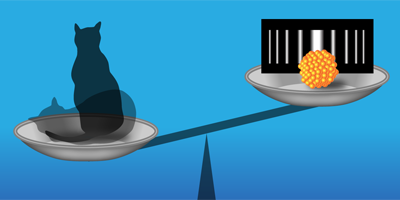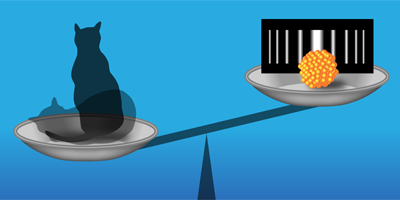Quantum-ness Put on the Scale
How much weirder would it be to see Schrödinger’s living/dead cat than to observe a tiny cluster of atoms interfering with itself in a double-slit experiment? That judgment might be in the eye of the observer, but physicists are interested in quantifying the effective size of macroscopic quantum objects in order to explore the border between quantum and classical physics. A new definition for this quantum size, or so-called macroscopicity, is based on how much leeway a given experiment leaves for quantum mechanics to be modified at a fundamental level. In a paper in Physical Review Letters, Stefan Nimmrichter of the University of Vienna, Austria, and Klaus Hornberger of the University of Duisburg-Essen, Germany, apply this formalism to a wide range of experiments, both completed and hypothetical.
Physics students learn early on how electrons and other particles behave both as particles and waves. But experimentalists continue to challenge our intuition with multiparticle objects existing in quantum superpositions of two or more states. Examples include tiny drums, superconducting circuits, and multiatom clusters. Although all of these experiments are impressive, it is not clear how to compare the collective size of their quantum behavior. Previous attempts to define the macroscopicity have tended to be model dependent; for example, they count the particles in a buckyball molecule as being either 60 carbon atoms or 1080 nucleons and electrons.
The authors have devised a universal formulation for the macroscopicity. They first imagined ways that the quantum equations could be modified towards a more classical representation. They then assigned a macroscopicity according to how many of these hypothetical modifications are ruled out by a particular experiment. The bigger a multiparticle quantum superposition is, the more modifications it rules out and the higher its macroscopicity. On the team’s logarithmic scale, state-of-the-art interferometer experiments with atoms and molecules earn macroscopicity grades of about 12. A proposed double-slit experiment with silica nanospheres would receive 20, whereas a simplified version of Schrödinger’s famous thought experiment on the quantum superposition of a cat earns the author’s highest score of 57. – Michael Schirber





